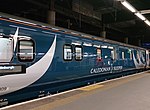The British Rail Mark 3 is a type of passenger carriage developed in response to growing competition from airlines and the car in the 1970s. A variant...
41 KB (4,531 words) - 10:46, 13 October 2024
British Rail Mark 1 is the family designation for the first standardised designs of railway carriages built by British Railways (BR) from 1951 until 1974...
32 KB (4,046 words) - 16:12, 17 August 2024
Mark 2 family of railway carriages are British Rail's second design of carriages. They were built by British Rail workshops (from 1969 British Rail Engineering...
23 KB (2,426 words) - 05:06, 8 August 2024
The British Rail Mark 4 is a class of passenger carriages built for use in InterCity 225 sets on the East Coast Main Line between King's Cross, Leeds...
17 KB (1,789 words) - 23:50, 16 June 2024
The British Rail Mark 5A is a type of railway vehicle in use in the UK. 52 standard carriages and 14 driving trailers were built by Spanish manufacturer...
12 KB (907 words) - 08:30, 22 September 2024
British Rail Class 37 is a diesel–electric locomotive. Also known as the English Electric Type 3, the class was ordered as part of the British Rail modernisation...
85 KB (8,599 words) - 21:35, 29 October 2024
317/318, as well as the diesel Class 150, they are based on the British Rail Mark 3, with a steel construction, unlike the earlier PEP based Class 313...
36 KB (3,177 words) - 10:28, 4 November 2024
The British Rail Mark 5 is the designation given to locomotive-hauled rail carriages built by Spanish manufacturer CAF for operation with Caledonian Sleeper...
10 KB (951 words) - 15:08, 21 April 2024
introduced by British Rail in 1966 for its long-haul express passenger services (see British Rail brand names for a full history). In 1982, the British Railways...
33 KB (3,270 words) - 05:00, 25 October 2024
power cars having been constructed by British Rail Engineering Limited's (BREL) Crewe Works and the British Rail Mark 3 passenger cars by BREL's Derby Litchurch...
65 KB (6,057 words) - 11:35, 3 November 2024










